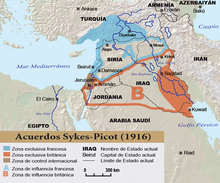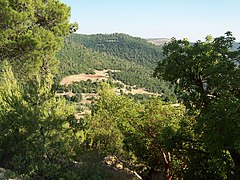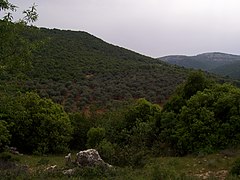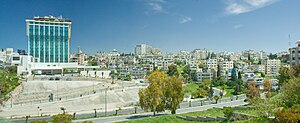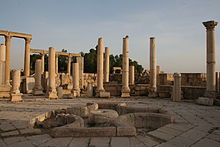Jordan
Jordan (in Arabic, الأردنّ, Al-'Urdunn), officially Hashemite Kingdom of Jordan (in Arabic, المملكة الأردنّيّة الهاشميّة, Al-Mamlakah al-Urdunīyah al-Hāshimīyah), called Transjordan until 1950, is a country in Asia located in the Middle East region Next. It borders Syria to the north, Iraq to the northeast, Saudi Arabia to the east and south, the Red Sea (in the Gulf of Aqaba) to the southwest, and the Dead Sea, Israel, and Palestine to the west. Its capital and most populous city is Amman.
The kingdom was created as a result of the division of the region carried out by France and the United Kingdom after the First World War. In 1946 Jordan became a sovereign and independent state with the initial name of the Hashemite Kingdom of Transjordan. Following the capture of the West Bank during the 1948 Arab-Israeli War, Abdullah I took the title of King of Jordan and Palestine.
Jordan is a constitutional monarchy in which the king (currently Abdullah II) holds broad executive and legislative powers. The country is classified as having high human development, according to the 2014 Human Development Report, as well as an emerging market thanks to the absence of armed conflict. Jordan has enjoyed advanced status in its relations with the European Union since 2010 and is a member of the Euro-Mediterranean Free Trade Area. The country was a founding member of the Arab League and the Organization of Islamic Cooperation.
History
Old Age
The land that later became Jordan is part of the historic Fertile Crescent region. Its history began around 2000 B.C. C., when the Semitic Amorites settled around the Jordan River in the area called Canaan. Subsequent invaders and settlers included the Hittites, Egyptians, Israelites, Assyrians, Babylonians, Persians, Greeks, Nabateans, Romans, Muslim Arabs, Christian Crusaders, Mamluks, and Ottoman Turks.
About 312 B.C. C., the Nabataeans took refuge in Petra, escaping from the Seleucid kings. They enjoyed relative independence, thanks to the decline of the Seleucid monarchy, which is why Petra became an important caravan stop. In the times of Pompey the Great, the Nabataean autonomy in Jordan was threatened, and finally, in 105 AD. C., the Romans annexed much of present-day Jordan to their empire, under the name of Arabia Petrea, with Petra as the capital. The province would try to revolt in the 3rd century, without success.
Middle Ages and Ottoman rule
In the seventh century, the current Jordan would be conquered by the Caliph Omar, but in the year 1100, during the First Crusade, Baldwin I of Jerusalem would make several incursions into the so-called Transjordan (in French, Outre-Jordain, meaning "beyond the Jordan", with the aim of controlling camel caravans that crossed the territories of present-day Jordan. During the crusades, the Franks took control of the entire region.Transjordan then became the Lordship of Transjordan, a vassal of the Kingdom of Jerusalem, which lasted until 1189, when Saladin occupied all of Transjordan, and remained under the rule of the Ayyubid dynasty until it passed into the hands of the Mamluks in 1259 and, in 1517, into the hands of the Ottomans.
The expansion of the Ottoman Empire, in the time of Selim I, collided directly with the Safavid Empire, in the 16th century, leaving the Jordanian territories caught in the middle. After the Safavid decline, the territories east of the Jordan were administered by the Ottoman Turks from 1518. Between 1900 and 1908, the Ottoman occupiers began construction of the Hijaz railway, which crossed present-day Jordan, with the aim of facilitating pilgrimage to Mecca from Damascus and sending troops to the Arab nations. This railway enhanced the development of Jordan. However, Arab resentment against the Turkish occupation was not abated.
World War I and British rule
During World War I, Britain took advantage of Arab nationalism, and after promising the creation of an independent Arab state encompassing Arabia and present-day Syria, Lebanon, Palestine, Israel, Jordan and Iraq, it promoted the Arab Rebellion. In this way, Arab troops, supported by British officers such as Lawrence of Arabia, managed to defeat the Turks and Germans in the Middle East, and the Hejaz railway suffered sabotage, especially in Jordan. The fall of the Jordanian port of Aqaba to Arab hands in 1917 doomed the Turkish forces, although the war would not end until September 1918.
At the end of the war, as agreed, the Ottoman Empire was dismembered, but the secret Sykes-Picot Agreements saw the light: they meant the division of the Middle East between Great Britain and France, betraying the Arab cause. Great Britain received from the League of Nations, the mandate over much of the Middle East, including the territory that now includes Israel, Jordan, and Palestine. Faced with the need to communicate Iraq with Palestine, both under British command, the current form of the Jordanian State was defined.
In 1922, the British partitioned the British Mandate of Palestine by establishing the semi-autonomous emirate of Transjordan east of the Jordan River, ruled by the Hashemite prince Abdullah I, though administration continued under a British high commissioner.
From independence to the present day
The mandate over Transjordan ended on May 22, 1946; on May 25, the country became the independent Hashemite Kingdom of Transjordan, with Abdullah I as its first king; however, its special defense treaty with the United Kingdom would not end until 1957.
The Kingdom of Transjordan opposed the creation of Israel in May 1948, and took part in the war between the Arab states and the new State of Israel (see 1948 Arab-Israeli War). The armistices of April 3, 1949 left Jordan in control of the West Bank. The Hashemite Kingdom proposed that the demarcation lines be established without prejudice to future territorial limits to be determined.
In 1950, the country was renamed the "Hashemite Kingdom of Jordan" by including the portions of Palestine annexed by King Abdullah. While acknowledging Jordanian administration of the West Bank, the United States maintained the position that final sovereignty over the West Bank would be the subject of new treaties.
After Syria and Egypt were united under the United Arab Republic in 1958, the Hashemite kingdoms of Jordan and Iraq were united under the name of the Arab Federation of Iraq and Jordan. However, a military coup in Iraq, led by Abdul Karim Qasim, ended the union with Jordan. Jordan then signed a mutual defense pact in May 1967 with Egypt and thus participated in the June 1967 war between Israel and the Arab states of Syria, Egypt, and Iraq. During the war, Israel gained control of the West Bank and East Jerusalem.
The 1967 war led to a dramatic increase in the number of Palestinians living in Jordan. Its Palestinian refugee population — 700,000 in 1966 — grew by another 300,000 from the West Bank. The period following the 1967 war saw a great increase in the power and importance of the Palestinian resistance elements (fedayeen) in Jordan. The heavily armed fedayeen posed a growing threat to the sovereignty and security of the Hashemite state, and open fighting broke out in June 1970.
Other Arab governments tried to mediate a peaceful solution, but in September fedayeen actions continued in Jordan, including the destruction of three hijacked international commercial planes being held in the desert east of Amman. This caused the government to act to regain control over its territory and population. In the ensuing battle, a Syrian tank force took up positions in northern Jordan to support the fedayeen, but was forced to withdraw by Jordanian forces. By September 22, Arab foreign ministers meeting in Cairo had agreed to a ceasefire that began the next day. Sporadic violence continued, however. In July 1971, Jordanian forces scored a decisive victory over the Fedayeen, driving them out of the country.
There was no fighting along the 1967 ceasefire line of the Jordan River during the Yom Kippur War in October 1973, but Jordan sent a brigade to Syria to fight Israeli units on Syrian soil. In 1988, Jordan renounced all claims to the West Bank but retained an administrative role pending a final settlement, and its 1994 treaty with Israel allowed it continued control over the Muslim Holy Sites in Jerusalem. The US government considers the West Bank to be Israeli-occupied territory, and believes that its final status should be determined through direct negotiations between the parties involved on the basis of UN Security Council resolutions 242 and 338.
Jordan diplomatically supported Iraq during the 1990-91 Gulf War. In 1991, it agreed with Syrian, Lebanese and Palestinian representatives to participate in direct peace negotiations with Israel sponsored by the United States and Russia. He negotiated a cessation of hostilities with Israel and signed a declaration to that effect on July 25, 1994. As a result, the Jordanian-Israeli peace treaty was concluded on October 26, 1994. After the start of the Al-Israel intifada Aqsa in September 2000, the Jordanian government offered its mediation to both parties.
Between 2012 and 2013, Jordan hosted thousands of refugees fleeing Syria, a country in the grip of a violent civil war. According to sources, more than 600,000 Syrians would find themselves refugees in Jordanian territory, which represents 10% of the Jordanian population.
Government and politics
Governance system
Jordan's system of government is a constitutional monarchy with a bicameral National Assembly, consisting of the 150-seat House of Representatives, 27 by proportional formula national constituency vote and 123 by "one man, one vote", and the Senate, of 75 members appointed by the king. The king and his Council of Ministers make up the Executive Power, and the king must approve all laws. However, his veto power can be overridden by 2/3 of both houses of the National Assembly.
The Senate is tasked with approving, amending, or rejecting bills issued by the House of Representatives (Lower House) and the House of Representatives is tasked with controlling the government and issuing investiture votes or votes of confidence and censure if this is the case, in addition to approving bills issued by the executive
The king appoints and removes judges by decree, approves amendments to the Constitution, declares war, and commands the Armed Forces. The decisions of the cabinet of ministers, the judicial sentences and the issuance of currency are carried out under his name. The Council of Ministers is chaired by the prime minister, and the king must remove a specific member of the ministerial cabinet if the prime minister requests it.
The Council of Ministers answers to the Chamber of Deputies on matters of general policy, and the cabinet must resign if the aforementioned legislative body casts a vote of “no confidence”, achieved with 2/3 of the Chamber. Jordan's 12 governorates are administered by their respective governors, appointed by the king. The Constitution provides for three types of Courts: Civil, Religious and Special. In addition to the Armed Forces, the king controls the General Intelligence Department, which is the Jordanian intelligence agency.
Jordanian Political Leaders
- 4th King of Jordan: (from 7 Feb 1999): Abdalah II of Jordan. It happened to his father Hussein of Jordan.
- Prime Minister (from 1 February 2011): Major General, retired in 1999, Marouf al-Bajeet. It happened to Samir Rifai.
- President of the Senate: Zaid al Rifal (2006)
- President of the Chamber of Deputies: Abdul Hadi al Majali (2006)
Human Rights
In terms of human rights, regarding membership of the seven bodies of the International Bill of Human Rights, which include the Human Rights Committee (HRC), Jordan has signed or ratified:
Political-administrative organization
Jordan is divided into twelve governorates (muhafazat, singular muhafazah):
| Province | Population (2008 est.) | Surface (km2) | Density (hab/km2) | Capital | Population (Metro, 2015 est) |
|---|---|---|---|---|---|
| Haman governorate | 1 939 405 | 8 231 | 246,3 | Haman | 4 405 470 |
| Irbid governorate | 950 700 | 1 621 | 570.3 | Irbid | 1 212 387 |
| Zarqa governorate | 838 250 | 4 080 | 205,5 | Zarqa | - |
| Al Balqa governorate | 349 580 | 1 076 | 324.9 | Salt | - |
| Al Mafraq governorate | 245 671 | 26 435 | 9,3 | Mafraq | - |
| Al Karak governorate | 214 225 | 3 217 | 66.6 | Karak | - |
| Jarash governorate | 156 680 | 402 | 379 | Jarash | - |
| Madaba governorate | 135 890 | 2 008 | 67.7 | Madaba | - |
| Ajlun governorate | 118 496 | 412 | 287,1 | Ajlun | - |
| Aqaba governorate | 107 | 6 583 | 16.3 | Aqaba | 148 416 |
| Ma'an governorate | 103 920 | 33 163 | 3.1 | Ma'an | - |
| At Tafilah governorate | 81 000 | 2 114 | 38.3 | At Tafilah | - |
Geography
Jordan is bordered by Iraq to the northeast, Saudi Arabia to the east and south, Israel and Palestine to the west, and Syria to the north. In total, its borders are 1,744 km long. Thanks to the Gulf of Aqaba, it has an outlet to the Red Sea, it also has shores on the Dead Sea. In total, Jordan has 26 km of coastline.
Its territory occupies an area of 89,342 km², so its extension can be compared to that of Portugal or twice that of Switzerland.
Jordan has an arid plain that covers the central and eastern regions of its territory, so only 3.32% of the land is arable. In the west, there are highlands. The Jordan Rift Valley and the Jordan River are Jordan's western natural borders. The lowest point is the Dead Sea (-408 m a.s.l.) and the highest point is the Jabal Umm ad Dami mountain with 1,854 m above sea level.
Climate
Jordan is predominantly a desert country, although Mediterranean forest and grassland biomes are also present in the west.
According to the WWF, the territory of Jordan is divided into five ecoregions: in the north, from east to west, the shrub desert of Mesopotamia, the steppe of the Near East and the forest of the eastern Mediterranean follow one another; the south is divided between the desert and xeric forest of Arabia and Sinai and the tropical desert and semi-desert of the Red Sea.
There are six nature reserves in Jordan, the Dana Biosphere Reserve, Wadi Mujib, Ajlun Forest Reserve, Dibeen Forest Reserve, Azraq Wetland and Shaumari Reserve. The last two are located near Azraq, but while the first is a wetland where migratory birds can be seen, Shaumari is a small reserve where you can see desert animals that have disappeared from most of the country, such as the Arabian oryx, the onager, the Persian gazelle and the ostrich.
Economy
Jordan is a small country with limited natural resources. Currently, the country is looking for ways to expand its water supply and make more efficient use of existing reserves, including regional cooperation. Jordan is also dependent on abroad for most of its energy needs. In the 1990s, its crude needs were met by imports from Iraq and neighboring countries. In 2003, construction of the Arab Gas Pipeline was completed, running from Egypt to the southern port city of Aqaba. The government intends to extend this pipeline north to the Amman area and beyond.
Since the year 2000, exports of textile products entering the US market have provided a boost to the economy. The government has placed particular emphasis on the potential of the information technology (IT) and tourism sectors as potential drivers of economic growth.
The World Bank classifies Jordan as an "upper-middle-income country." However, approximately 14.4% of the population lives below the national poverty line in the long term (as of 2010), while almost a third fell below the national poverty line at some time of the year (known as "transient poverty"). The economy, which has a GDP of 39,453 million dollars (as of 2016), grew at an average rate of 8% per year between 2004 and 2008, and around 2.6% in 2010. GDP per capita it increased 351% in the 1970s, decreased 30% in the 1980s, and increased 36% in the 1990s, and is currently $9,406. The Jordanian economy is one of the smallest economies in the region, and the country's population suffers from relatively high rates of unemployment and poverty.
Education and literacy rates are relatively high compared to other countries with similar incomes. The proportion of well-educated and skilled workers in Jordan is among the highest in the region in sectors such as ICT and industry, thanks to a relatively modern education system. This has attracted large foreign investment to Jordan and has allowed the country to export its labor force to the Persian Gulf countries.
Tourism
Tourism is a sector of key importance to the Jordanian economy. Together with the country's political stability, its geography makes it a highly attractive tourist destination. The main tourist activities in Jordan include the visit of numerous ancestral places and unexploited natural enclaves, going through the approach to religious and cultural places and their traditions. Highlights:
- The city of Petra, the most attractive tourist spot in Jordan, home to the Nabateans. It occupies a valley that can only be accessed through a long parade, and its buildings, most graves and temples of the centuryIIThey're excavated in the sandstone rock. The Treasure of Petra, the Monastery or Deir and the remains of the Roman city stand out. The city is considered one of the Seven Wonders of the Modern World.
- Gerasa and Gadara, two old Roman cities that were part of the Decapolis, a set of ten cities of the Roman era that were part of the Roman Empire of the East. The first, which in many guides is written as in English, Jerash, is preserved in very good condition and is a good example of the Roman architecture of the centuryI. Gadara, best known today as Umm Qais, is not only a beautiful Roman city, but enjoys a magnificent view of the sea of Galilee, the city of Tiberias and the valley of the river Yarmuk.
- Haman, the capital of Jordan, who in his day was part of the city with the name of PhiladelphiaIt is both a Roman city, with its theaters, forums, temples and avenues, as a Muslim, with colourful and varied mosques and the Alcazar, as a Christian, with its beautiful Byzantine churches.
- The castles of the desert, east of Haman, are part of a route greatly appreciated by the tourism that includes a twenty castles and fortified Muslim palaces, built in the 7th and 8th centuries by the Umayyads. Under this denomination there is also some hamman and some caravasar. They highlight, in this context, the Qusair Amra complex, for its paintings of the centuryVIIIand the well-preserved Qasr Kharana castle.
- In Jordan there are, in addition to the desert castles, other very remarkable, since it is on a key route in the fertile Crescent of Antiquity, it was the eastern border of the Roman Empire, and from the centuryVIIJoin Mecca with Damascus. The castle of Ajlun stands out, Qala'at ar Rabad, located about 15 km north of Gerasa and the only fortress built by the Muslims at the time of the Crusades, in the centuryXIIand the castle of Karak, Qal'at al-Karak, built in the centuryXII by the Crusaders to control the route that unites the Nile with the Euphrates, in what is known as the Camino de los Reyes or route of the Kings, which currently unites Haman and Arabia. In this real route there are other imposing fortresses, such as the Shawbak castle, built by the Crusaders with the name of Montreal. From here you can see the mountains that descend to the Arab Wadi or Aravá, desert valley that unites the Dead Sea with the Red Sea.
- Madaba, the city of mosaics, on the route of the Kings, is an important Christian center, well known for the so-called map of Madaba or map of the Holy Land, the oldest map of the world made on mosaic, on the floor of the Greek-Orthodox church of St. Nearby is Mount Nebo, where it is said that God denied Moses the entrance to the promised land; after the papal visit to this place a great church has risen and has been promoted as a tourist centre for its views over the Dead Sea.
- The Dead Sea, the lowest place on Earth, 411 meters below sea level and losing height due to the desertization of the region. It is not a true sea, but a saturated lake of potassium and magnesic salts. The salt content exceeds 60 grams per litre and allows you to float without strength. It is attributed therapeutic properties.
- Between the route of the Kings and the Aravá you will find the Dana Biosphere Reserve, an important natural reserve ideal for hiking in a deep and fascinating valley.
- Aqaba is a city in the Gulf of this same name in the Red Sea. It is an extraordinary beach place, carefully planned and equipped. It is also important center for the practice of submarinism thanks to corals.
- The Wadi Rum desert, in southern Jordan, very close to the Red Sea, one of the most seductive places for tourism in this country. It is a desert known all over the world because there was filmed the film Lawrence of Arabia, Among the activities that can be done on a trip to the Wadi Rum desert are the safari in 4×4 and adventure hiking, camping in the desert.
Demographics
According to 2018 estimates, the Jordanian population numbers more than 9,956,000. About 70% of Jordan's population is urban; less than 6% of the rural population is nomadic or semi-nomadic. Most people live where rainfall helps agriculture. Some 2.2 million people are registered as Palestinian refugees and displaced residents in Jordan, the majority as citizens. Only five of the most important cities in the country exceed 200,000 inhabitants: the capital Amman (4,007,526), Zarqa (1,365,000), Russeifa (481,900), Irbid (1,770,000) and Cuaismeh (214,232).
Jordanians are mostly Arabs (98%), except for small communities of Chechens, Circassians, Armenians, and Kurds who have adapted to Arab culture.
The official language is Arabic, but English is generally spoken as a second language by the merchant classes or members of the government. However French is a good option and taught in several schools and is spoken by many Jordanians.
The official religion of Jordan is Islam with a majority of Sunni Muslims Sunni Islam (93.5%), followed by Christianity (4.1%), the majority being Greek Orthodox, but there are minorities of Catholics, Copts, Armenians, Protestants and Syrian Orthodox. A remaining 2.4% are Shiites and Druze (2001 est.). In general, coexistence between Muslims and Christians is quite cordial, and Christmas Day is a national holiday. The Seventh-day Adventist Church is recognized in Jordan by royal decree as a religious organization. (https://www.interamerica.org/es/2020/02/expansion-drastica-de-escuela-adventista-en-jordan/).
According to the Embassy of the Kingdom of Jordan in Spain in the kingdom "there is religious freedom although said freedom can be undermined by social pressures that affect the freedom of choice of citizens". "Such pressures are not the result of fashion or government control because they emanate from deep-rooted traditions, but they were in no way institutionalized in the form of prohibitions or legally regulated". Furthermore, the Jordanian government does not arbitrarily withhold its official recognition of some religious congregations or religions, as long as they are consistent with public order and morality. A study published in 2022 estimates that in 2010 there were about 6,500 Christian converts from Islam in the country.
The fertility rate is 2.55 children per woman, but the infant mortality rate is 16.16 deaths per 1,000 births. The annual population growth is 2,412%. Life expectancy at birth is 74.1 years: 72.79 years for men and 75.5 years for women. Like other Muslim-majority nations, the percentage of people alive with HIV is very low, less than 600 people, although it is estimated that 500 have already died.
Culture
On Jordanian territory, literacy is 95.9%: 97.7% for men and 93.9% for women.
Jordan has an immense Ottoman and Arab influence, which shows in its architecture, which even has Roman and Phoenician overtones.
Gastronomy
Jordanian cuisine is characterized by the extensive use of vegetables including baked, stir-fried, and grilled (with vine leaves, eggplant, etc.), as well as meat and poultry. Roasts and preparations with spiced sauces are also common in the country's cuisine. Being one of the largest olive producers in the world, olive oil is the most used for cooking in Jordan. Herbs, garlic, spices, onions, tomato sauce and lemon are the typical flavors found in Jordanian dishes. The most representative dish of Jordanian gastronomy is mansaf, made with lamb, rice and a dry yogurt called jameed. It is considered by many to be the national dish of Jordan.
Jordanian Holidays
| Date | Holiday | Notes |
|---|---|---|
| 1 January | New Year | |
| 30 January | Birthdays of King Abdallah I | Cancelled by King Abdalah II |
| 1 May | Workers' Day | |
| 25 May | Independence Day | |
| 9 June | Ascense to the throne of Adbala I | |
| 14 November | King Hussein's birthday | Cancelled by King Abdalah II |
| 25 December | Christmas | By Law, businesses and schools can extend this period for up to five days |
| End of the Hajjj | Eid ul-Adha | Commemorates the attempted sacrifice of Abraham of his son Ishmael |
| End of Ramadan | Eid ul-Fitr | Commemorates the end of the month of Ramadan |
| Not specific | Muharram | New Islamic Year |
| Not specific | Miraj | Ascense of Prophet Muhammad to Heaven |
| Not specific | Birthdays of the Prophet Muhammad |
Due to the Christian population in Jordan, Christians who are self-employed may not do so at Easter. Christian schools also have the right to suspend activities, something that is controversial in Jordan.
Sports
Since 1981, the Jordan Rally has been held, a test that was scored on several occasions for the Middle East Rally Championship. In 2008 it entered the World Rally Championship calendar, a fact that was repeated in 2010 and 2011. The driver who has won this test the most times is Mohammed Bin Sulayem, winner twelve times. In 2016 it hosted the V FIFA U-17 Women's World Cup.
Contenido relacionado
Albalate de Zorita
Politics of Venezuela
Dry it

